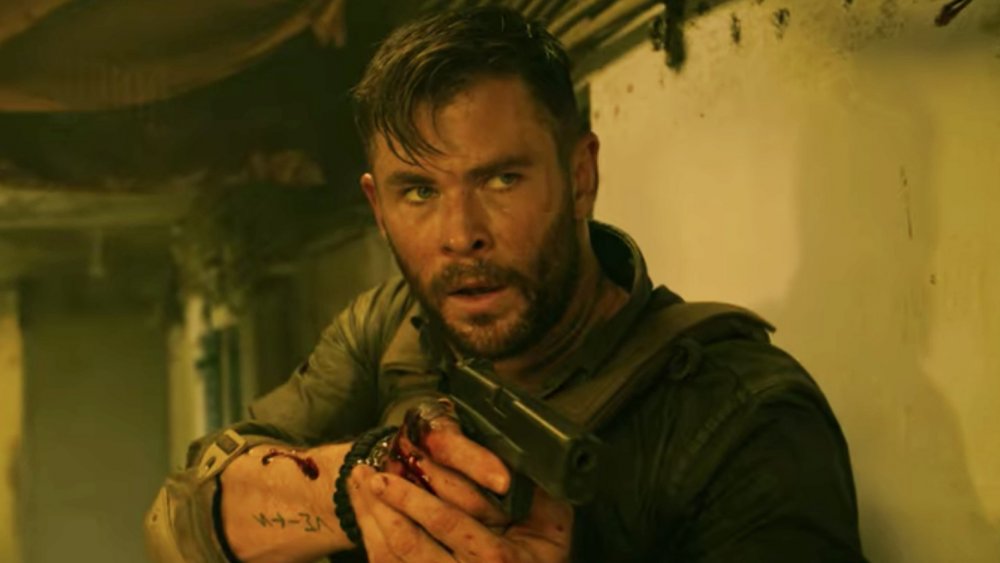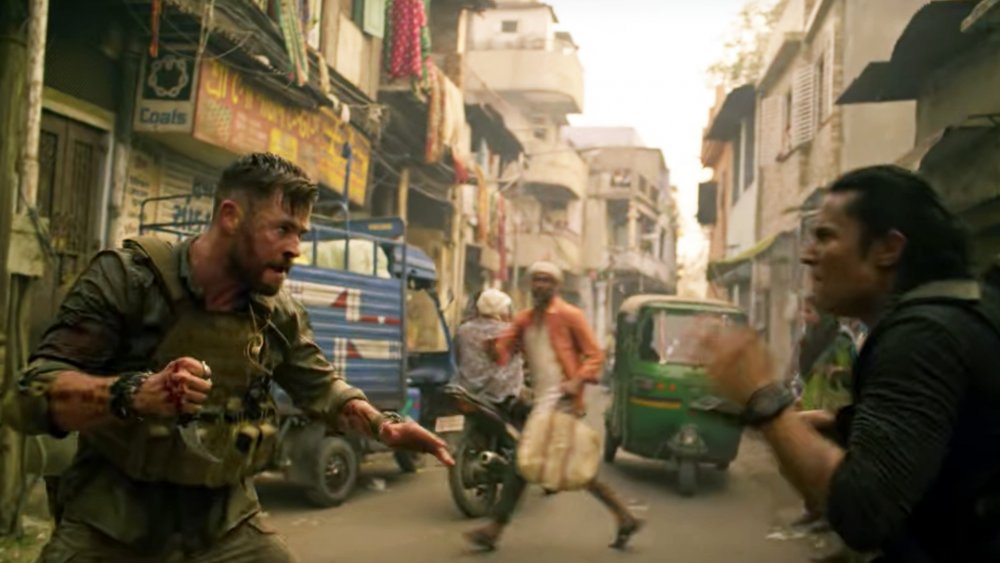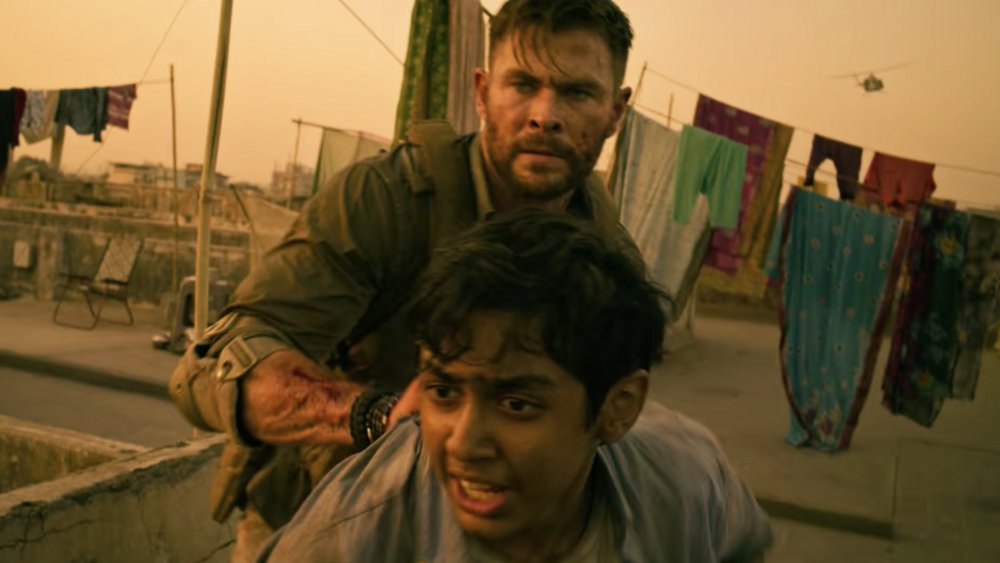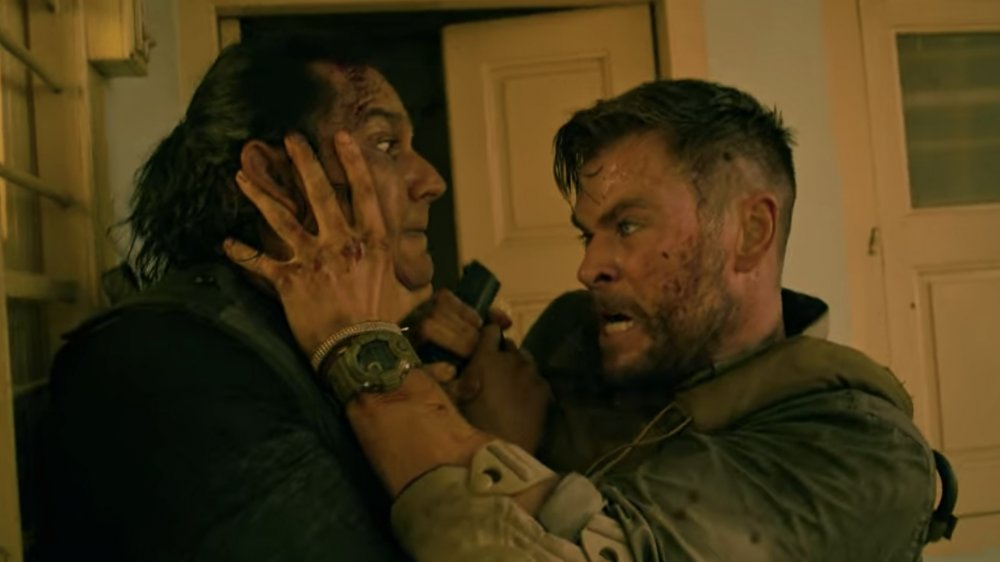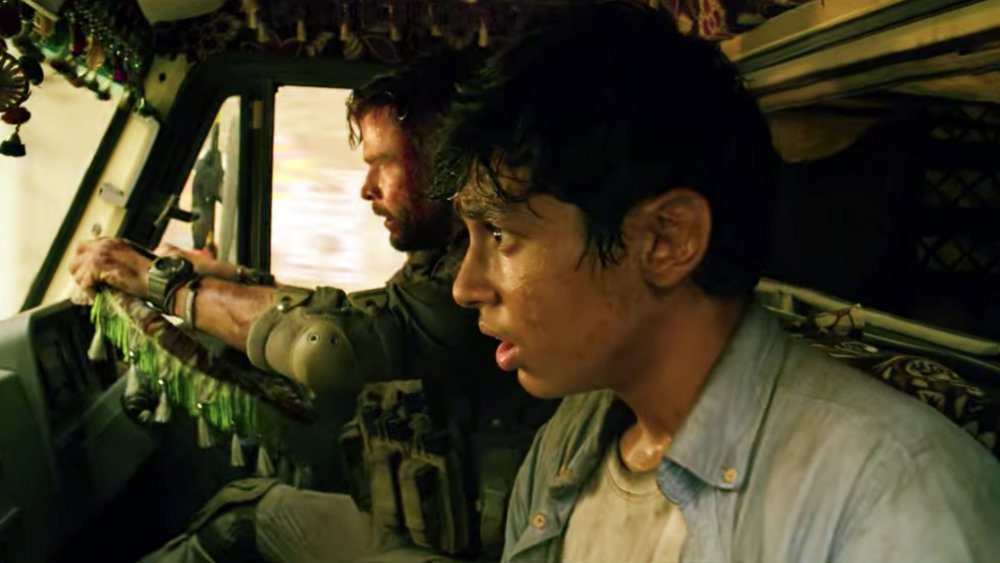The Untold Truth Of Extraction's 12-Minute 'One-Shot' Sequence
There's a lot to get excited about in Netflix's Extraction. There's the story — centered around ex-Australian Special Air Service Regiment operator and current black-market mercenary Tyler Rake, who's tasked with rescuing the son of an Indian crime lord from that criminal's nefarious rival, and who's dealing with unresolved mental trauma of his own. There's the cast — led by Marvel Cinematic Universe legend Chris Hemsworth as Tyler Rake and featuring Rudhraksh Jaiswal as Ovi Mahajan Jr., David Harbour as Gaspar, Golshifteh Farahani as Nik Khan, Randeep Hooda as Saju Rav, and more. There's also the talented creative team — director Sam Hargrave (an MCU stunt coordinator), producers Joe and Anthony Russo (the directors of Avengers: Endgame), and cinematographer Newton Thomas Sigel (who's worked on X-Men films, Bohemian Rhapsody, and Drive).
But one thing that fans have been talking about with an added dose of vivacity is a particular sequence in the film: the 12-minute extended scene that's filmed and edited to look like it was shot in one continuous take.
Joe Russo (who also wrote the script for Extraction), Hargrave, and Hemsworth spoke at length about the scene during an IGN-hosted livestream event for the film, held on April 30, 2020. In conversation with IGN senior producer Clint Gage, the trio divulged juicy tidbits and impressive details about Extraction's 12-minute "one-shot" sequence.
Extraction's director fought to make the 12-minute action scene happen
In a reveal that evoked Russo's info-drop that the opening scene of Extraction was changed from page to screen earlier in the livestream, Hargrave stated that the one-take-esque sequence "wasn't planned that way." According to Russo, it was "originally just scripted as a protracted action sequence" — inspired by attention-grabbing, tension-filled scenes from movies past. "What I love from '70s thrillers — think about the car chase from French Connection — you're immersed in pure action for a protracted period of time, and it doesn't let you go. [It's like] the bank heist from Heat, any of the car chases from Ronin," said Russo. "So this was originally just scripted as a long action sequence."
Extraction fans have Hargrave to thank for turning the scene as it was originally penned into the epic sequence seen in the film. Russo explained during the livestream that Hargrave gunned hard for a "one-er" to happen, and truly dedicated himself to that mission.
"It was Sam's idea, and Sam fought for the notion of a 'one-er,' because he felt [...] it would be more immersive. He committed months of his time to conceiving this and executing it, and it's exceedingly difficult," said Russo. "He put himself in harm's way — in a way that very few directors would to capture these shots on his own."
Extraction director Sam Hargrave wanted to do something different and immerse the audience
Hargrave's mind was indeed turning over like mad when he first laid eyes on the scene as it was initially written in the Extraction script. Rather than aim to direct it from an expected angle, using more traditional techniques, or in a way that directly matched what was seen on the page, though, Hargrave ventured to do something unique — both to better tell the story and to draw audiences in even further.
"When I read that scene, I couldn't stop turning the page. It was one of those things, just for me, [where] it came down to, 'How do I tell this kind of action scene in a way that might be a little different than movies of the genre that have come before?'" the director said.
He continued, "It's not totally different — 'one-er's have been done before, and some entire movies have been done that way — but I wanted to, from a creative standpoint, grab the audience and say, 'You're coming with us. We're going in — we're getting out of Dhaka, we're taking this kid, and we're going.' So that the camera then becomes a character and you get to experience this stuff in realtime. You get to be surprised when Hemsworth's [character is] surprised — you only know as he knows it."
In addition to creating an immersive experience for the audience, Hargrave also wanted the 12-minute-long sequence in Extraction to build the relationship between Hemsworth and Jaiswal's characters: "You see the relationship between Tyler and Ovi grow during this [scene], and that was the sort of creative emphasis."
Filming the 'one-er' in Extraction was intense but rewarding
For the vast majority of action movies, actors are required to endure some physically and/or mentally taxing days on set. There may be dangerous stunts that need to be performed (even with the aid of a stunt double), chase sequences that must be shot over and over again so that the filmmaking team has enough material to work with during the edit, or scenes that involve lots of physical activity and are set to be filmed in excessively hot or cold climates. And then there are sequences like the 12-minute one in Extraction, which essentially asks of its actors all three of the above-mentioned things.
Hemsworth opened up during the Extraction livestream about what it was like filming the "one-er," admitting that it was challenging but noting that it was all worth it in the end because the scene felt super-charged with the same energy he was feeling while performing.
"It was intense to shoot, and it's intense to watch. [...] I was introduced to it probably a couple of months before shooting. Sam said he wanted to attempt this 12-minute 'one-er,' and I thought, 'Oh yeah, cool. Sounds fun!' And then [I] didn't realize it was going to be as intense and physically challenging as it was," said Hemsworth. "And we just did weeks and weeks of rehearsals, and as we were shooting each day, we'd be shooting the next sequence, and the next day, what was coming up. Everything was sort of overlapping and intense, but it adds to the energy of what you see."
Later, Hargrave noted that there wasn't a green screen involved during the scene — no CGI or digital effects were added in later during post-production. It was all raw, real, and unfolding right before the actors' eyes. "It's all them in the car," he said. "The realism I wanted was another part of this."
Hemsworth piggybacked off that comment, sharing, "You're completely immersed in the moment — not only as the character, but [also] as the performer. You're not having to act afraid, nervous, elevated heart rate, out of breath, because you truly are. It was intense." He continued, detailing that getting the timing exactly right was quite stressful, but when all is said and done, he actually finds green screen work to be much harder than what was done in Extraction.
"It's certainly way more enjoyable. The hardest stuff, I find, is green screen, soundstage, just numbing lights, no energy, no environment to react off and interact with," Hemsworth said, adding with a laugh that he wasn't just talking about his time playing Thor in the Marvel Cinematic Universe, but about his entire career outside of Extraction.
Sam Hargrave put his literal back into the long-shot sequence in Extraction
Hemsworth admitted during the livestream event for Extraction that he initially brushed off Hargrave's comments about filming the 12-minute-long sequence in such a way that the camera felt like another character watching everything play out. "I remember Sam saying, you know, 'making the camera a character,' and I thought, 'Eh, okay, whatever,'" he said, explaining that directors tend to use unique phrasing to explain certain visions they have and that he's gotten used to that over the years.
But this time around, there was something striking about Hargrave's approach: He was legitimately going all-out in making the camera a character. Hemsworth recalled, "When I saw him strapped to the front of the car and diving off the building with the stunt guys and falling down the stairs with it, I thought, 'Wow. He really wasn't lying. He wasn't exaggerating. He's actually doing it.'"
At one point in the sequence, Hargrave was working a camera with a lens just three feet away from cars zooming down dirt roads, zipping through tunnels, and drifting around corners. The director was so dedicated to getting the continuous-take-looking scene perfect that he strapped himself to the hood of a car to capture the footage when the "camera vehicle that we were using before wasn't able to drift these corners and get [...] this close." Hargrave further explained that the vehicle simply "didn't have enough power," but taking an alternate (though riskier) approach worked out in the end: "It allowed me to get this shot, where when the car stopped, they just released and I could slide right off the hood and then dive right into the back of the car."
"Depending on the necessity of the shot, we used different tools," Hargrave said with a smile, "and sometimes, I had to strap myself to the hood of a car."
You know what they say: We all pour our blood, sweat, and tears into what we love. By that adage's approximations, Hargrave, Hemsworth, and the entire Extraction team don't just love the movie — they were willing to give everything they had to make it as awesome as possible.
